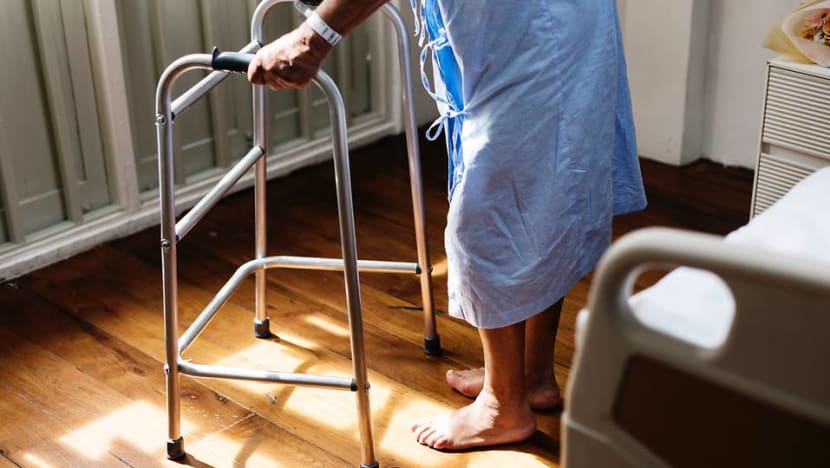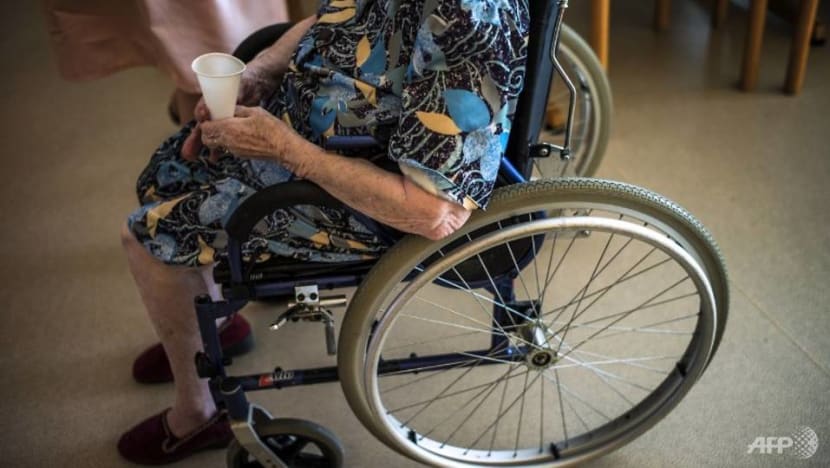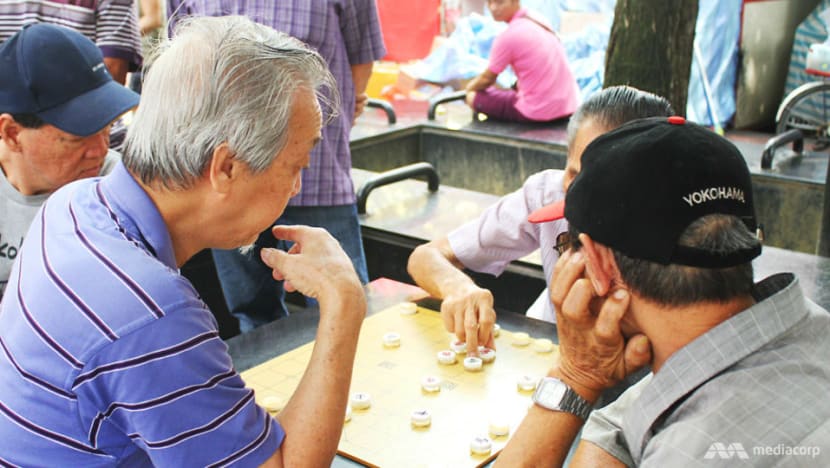commentary Commentary
Commentary: Caregivers are getting some support but deserve more care
Consider how financial payments for family care can address the economic consequences of family caregiving, and how their impact can be maximised by providing linkages to other policy domains such as employment and formal care, says AWARE’s Shailey Hingorani.

An elderly man. (File photo: AFP/JEAN-CHRISTOPHE VERHAEGEN)
SINGAPORE: During his budget speech, Finance Minister Heng Swee Keat acknowledged the economic impact of caregiving on women when he announced that the 300,000 Singaporeans, aged 50 to 64 in 2019, to benefit from the CPF top-up of up to S$1,000 will mostly be women.
Many, he said, “left the workforce early, and took up important roles as mothers, caregivers or housewives.”
In a similar vein, last week the Government announced a monthly Home Caregiving Grant (HCG) of S$200 to replace the monthly Foreign Domestic Work Grant of S$120. This would allow care recipients to choose their preferred care options.
One of these options is paying their family caregivers, who more often than not are their female spouses or unmarried daughters. HCG and other similar measures, like more respite care options and increased budget for Flexible Work Arrangements, are part of the government’s new initiative to beef up support for family caregivers.
READ: 7 things you need to know about Budget 2019, a commentary
A SUBTLE SHIFT THAT MISSES THE MARK
The CPF top-up and HCG are significant because they are indicative of a subtle shift in policy thinking.
They recognise the financial cost of family caregiving by providing a CPF top-up for low-income individuals who have less than S$60,000 in their retirement savings, and for the first time, a financial payment to family caregivers of seniors to defray costs associated with long-term care.
But a one-off S$1,000 top-up and a grant of S$200 aren’t enough to compensate caregivers for foregone earnings. Nor do they cover out-of-pocket care-related expenses, such as salary payments to foreign domestic workers (FDW).

AWARE has advocated for CPF top-ups and a caregivers’ allowance through its annual Budget submissions, not only as a measure to acknowledge the economic burden of caregiving - which is substantial - but also to offer societal recognition of the valuable work done by family caregivers.
CPF top-ups and HCG are crucial first steps. Yet countries that offer caregiver payments, allowances and supplements show Singapore how far we have to go.
These countries, such as Australia and Ireland, comprehensively recognise that payment for family care must take a serious view of the economic consequences of family caregiving, and provide easy linkages to formal care services so that caregiving responsibilities can be shared between home and community.
LISTEN: What life in your 60s should look like, an episode on The Pulse podcast
ECONOMIC CONSEQUENCES OF FAMILY CAREGIVING
1. Decreased labour force participation. Unlike the emotional and physical burdens of family caregiving, which are relatively well documented, caregiving’s economic consequences have not received as much attention from policy makers.
These consequences include loss of income and retirement savings (because of reduced, delayed or interrupted labour force participation); out-of-pocket expenditure of co-payments for formal services to complement family care; and additional expenses incurred in the consumption of care-related goods and services.
These are significant costs for all family caregivers regardless of income, but more so for the low- to middle-income persons that the CPF top-up is targeted at.
An analysis of the Labour Force Survey from 2016 to 2018 shows a marked increase - from 39,300 to 75,800 - in the number of women who cited caregiving for relatives and older persons (and not children) as their main reason for being out of the labour force.

We see a similar increase in the numbers of men citing caregiving for relatives and older persons over the same time period - from 8,200 in 2016 to 13,000 in 2018.
READ: The unequal, unnoticed life of a female worker, a commentary
2. Cost of hiring help at home. According to MOM, there are 250,000 FDWs in Singapore today. Although there is no publicly available data on how many of these care for older persons, the last national survey on informal caregivers conducted in 2011 pointed out that Singaporean families care for their old members with a heavy reliance on FDWs.
Given shrinking family sizes, the reliance on FDWs is only set to increase, as are the associated expenses for paying them.
A forthcoming study from AWARE that interviewed 23 family caregivers (between the ages of 45 and 65) of seniors shows that salary payments to FDWs are the single largest recurring out-of-pocket expense for families, even after subsidies.
On average, caregivers spent S$655 per month per FDW. The HCG payout, which is S$80 more than the FDW Grant, would bring this cost down but not substantially.

FINANCIAL PAYMENTS FOR CAREGIVERS – TWO APPROACHES
Many experts acknowledge that financial payments for caregivers cannot fully compensate for foregone earnings, for the full value of the care work performed costed to the level of payment for full-time salaried care workers, or even for the largest out-of-pocket expenses.
But policies can be designed to be effective even while offering low sums.
They can provide automatic access to formal care services so that caregivers do not have to incur the time cost of applying for these services separately, and provide insurance cover for temporary periods of unemployment, to ensure that family care does not completely impoverish caregivers.
Financial compensation policies can be targeted at either care recipients to allow them greater flexibility in choosing their preferred care options, including payment to a family caregiver - although this might impose an administrative burden on care recipients who require care support precisely because they are unable to perform Activities of Daily Living by themselves. Or they can be targeted at caregivers.
Both approaches have implications for how we conceptualise the relationship between care recipients and caregivers, the transaction costs involved in accessing financial payments, and what impact, if any, providing cash for care has on the caregivers’ ability to participate in the labour force.
READ: If more work in old age, how relevant is the retirement age? A commentary
FINANCIAL PAYMENTS TO CARE RECIPIENTS
Countries such as Austria, France and Germany have adopted this approach to offer financial payment to care recipients without any formal requirements for how it should be used. Singapore too has firmly gone in the direction of this approach.
However, Singapore’s approach departs from Germany’s policy design by being government sponsored, and by keeping financial payments transferable to caregivers separate from their eligibility to access community- and home-based care.
Germany’s approach - insurance-based integrated financial payment and access to services - automatically activates when care recipients who are able exercise the choice to transfer payments to caregivers.
Upon receiving payments, caregivers are entitled to four weeks of respite care and contributions to their pension and accident insurance.

The integrated approach seems more comprehensive because it provides care recipients greater flexibility in choosing their preferred care options through individual consultations with care advisors and minimises the transaction costs for caregivers to access home- and community-based services (because they are automatically enrolled).
The Government in Singapore has announced more respite care options, which will definitely help with the caregiving burden. However, from the details available in the public domain so far, it does not seem that the Government will adopt the mixed-model approach of Germany.
FINANCIAL PAYMENTS TO CAREGIVERS
Some consider the second approach, adopted by countries such as Australia, to be more radical because it recognises that caregivers have a right to a source of income independent of the rights, entitlements or wishes of care recipients.
This approach is arguably the more expensive option, but the Government could finance it by considering progressive taxation measures, like increasing personal income tax for the wealthy, or introducing a wealth tax (e.g. capital gains tax, inheritance tax).
This approach encompasses at least two different policy designs: Providing payment to low-income caregivers for providing full-time care, and providing employment insurance during temporary absences from employment because of caregiving responsibilities.
Australia costs these to provide substantial financial relief to caregivers.
Family care has been undervalued for far too long. HCG and other measures to support caregivers are welcome, but Singapore can and must do more to recognise the unsung heroes of our time.
We must carefully consider how financial payments for family care can address the real economic consequences of family caregiving, and how we can maximise their impact by providing linkages to other policy domains such as employment and formal care. Our caregivers deserve to be cared for too.
Shailey Hingorani is head of advocacy and research for the Association of Women for Action and Research (AWARE).














